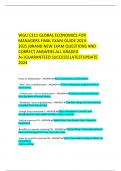WGU C211 GLOBAL ECONOMICS FOR
MANAGERS FINAL EXAM GUIDE 2024-
2025|BRAND NEW EXAM QUESTIONS AND
CORRECT ANSWERS ALL GRADED
A+|GUARANTEED SUCCESS|LATESTUPDATE
2024
Views on Globalization - ANSWER-✔New, Evolutionary, and Pendulum
"New" view on globalization - ANSWER-✔A force sweeping through the world in
recent times.
"Evolutionary" view on globalization - ANSWER-✔A long-run historical evolution
since the dawn of human history
"Pendulum" view on globalization - ANSWER-✔One that swings from one extreme
to another from time to time
Foreign Direct Investment - ANSWER-✔Direct investment in, control, and
management of value-added activities in other countries
Political views on FDI - ANSWER-✔Radical View, Free Market View, Pragmatic
Nationalism
n
Benefits to a country receiving FDI - ANSWER-✔Capital Inflow, Technology Spillover,
Advanced Management Know-How, Job creatio
Costs to a country receiving FDI - ANSWER-✔Loss of Sovereignty, Adverse effects on
competition,
Capital outflow.
, How do resources and capabilities influence the competitive dynamics of a business?
- ANSWER-✔Resource similarity and market commonality can yield a powerful
framework for competitor analysis.
Resource similarity - ANSWER-✔The extent to which a given competitor possesses
strategic endowment comparable, in terms of both type and amount, to those of the
focal firm.
How does resource similarity impact competitive dynamics? - ANSWER-✔Firms with
a high degree are likely to have similar competitive actions. (Starbuck's instant coffee
& McDonald's iced coffee)
Classical theories of international trade - ANSWER-✔Mercantilism, Absolute
advantage, and Comparative advantage
Modern theory view - ANSWER-✔Dynamic
Classical theory view - ANSWER-✔Static
Absolute advantage - ANSWER-✔The economic advantage one nation enjoys that is
superior to other nations
Comparative advantage - ANSWER-✔The advantage one economic activity nation
enjoys in comparison with other nations (relative, not absolute)
Mercantilism - ANSWER-✔A theory that suggests that the wealth of the world is
fixed and that a nation that exports more and imports less will be richer.
Features of the product life cycle? - ANSWER-✔New, Maturing, and Standardized
Strategic trade - ANSWER-✔Intervention by governments in certain industries can
enhance their odds for international success.
How are supply and demand related to the exchange rate of a country? - ANSWER-
✔The price of a commodity, a country's currency, is fundamentally determined by
this. Strong demand leads to price hikes; oversupply results in price drops.
Which theory came first? - ANSWER-✔Mercantilism (although both are of the idea
that governments should actively protect domestic industries from imports and
vigorously promote exports)
If a company seeks to limit foreign exchange rate exposure in the forward direction,
what is the most effective way to do this? - ANSWER-✔Forward transactions, an act
know as currency hedging.
Transaction risk - ANSWER-✔The exchange rate risk associated with the time delay
between entering into a contract and settling it.
, Hedging - ANSWER-✔A transaction, such as forward transactions, that protects
traders and investors from exposure to the fluctuations of the spot rate.
Currency hedging - ANSWER-✔A way to protect traders and investors from being
exposed to the fluctuations of the spot rate
Strategic hedging - ANSWER-✔A means of spreading out activities in different
currency zones in order to offset the currency losses in certain regions through gains
in other regions (currency diversification)
First mover advantages - ANSWER-✔Proprietary, technological leadership, pre-
emption of scarce resources, establishment of entry barriers to late entrants,
avoidance of clash with dominant firms at home, relationships with key stakeholders,
(such as governments.)
Late mover advantages - ANSWER-✔Opportunity to free ride on first-mover
investments, Resolution of technological and market uncertainty, First mover's
difficulty to adapt to market changes.)
Foreign market entries types - ANSWER-✔Non-equity and equity
Non-equity - ANSWER-✔Reflects relatively smaller commitments to overseas
markets. Determines firms MNE status.
Equity - ANSWER-✔indicative of relatively larger, harder-to-reverse commitments.
Determines firms MNE status.
How do institutions reduce uncertainty? - ANSWER-✔Establish "rules of the game"
that economic players play by. A standard to follow in order to survive and prosper.
By signaling which conduct is legitimate and which is not, institutions constrain the
range of acceptable actions.
Regulatory pillar - ANSWER-✔The coercive power of governments (laws, regs, rules)
Normative pillar - ANSWER-✔Values, beliefs, and actions of other relevant players
(norms, cultures, ethics)
Cognitive pillar - ANSWER-✔The internalized, taken-for-granted values and beliefs
that guide behavior. (beliefs between right/wrong)
Formal institution - ANSWER-✔One that include laws, regulations and rules
Informal institution - ANSWER-✔One that includes norms, cultures and ethics




